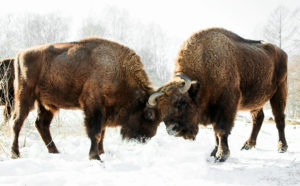Bison
Used to roam in huge herds across North America Europe and Russia

American Bison
Slowly returning as reintroduced herds to Plains areas of USA and Canada. About 20000 strong now and increasing
Yellowstone National Park Idaho, Montana, Wyoming Yellowstone National Park is perhaps America’s best-known place for viewing bison. The park is home to the largest population of non-commercial, free-range bison. Today, close to 5,000 purebred animals live freely within Yellowstone. According to the National Park Service, it is the only place in the country where bison have lived continuously since before their near-extinction and rehabilitation. Yellowstone Guidelines leads private tours into the park to spot large wildlife, including bison.
American Prairie Reserve Montana Since 2004, American Prairie Reserve, a nonprofit wildlife reserve in northern Montana, has been gradually purchasing and leasing tracts of grasslands in an effort to reconnect 3 million acres of public lands and foster them back to unfenced, undeveloped plains wilderness. On the 31,000-acre Sun Prairie parcel, a bison herd roams freely. If you visit in the fall, the bison herd tends to gather in big groups.
Antelope Island State Park Utah The 42-square-mile Antelope Island preserve in the middle of the Great Salt Lake is separated from mainland Salt Lake City by a 7-mile causeway. The herd of as many as 700 bison are easy to spot. The ancestors of this herd have roamed freely on the island since 1893, making it the second-oldest publicly owned bison herd in the nation, after Yellowstone. An annual bison roundup takes place in the park each October, where horseback riders corral the herd, but due to COVID-19, spectators were discouraged from attending this year.
Catalina Island California In 1924, 14 bison were brought to Catalina Island off the coast of California, allegedly for the filming of a Western movie. Whatever their origins, these bison number around 150 today. When numbers have exceeded that in the past, bison have been relocated to Native lands, including that of the Morongo Band of Mission Indians, the Rosebud Indian Reservation in South Dakota and elsewhere. Catalina Island Conservancy, a nonprofit land trust that protects nearly 90 percent of the island, offers Eco Tours that provide an opportunity to see bison and learn about the Catalina Island’s history. Catalina Island Company also leads a two-hour, off-roading bison expedition to spot the herd from a safe distance.
Henry Mountains Utah Today, the Henry Mountains in southern Utah are home to between 300 and 500 free-roaming bison. You can spot them from the low grassy plains to the mountain-top flatlands at elevations up to 10,000 feet. The managers of this herd have also begun to send bison to seed herds in other places, including the Book Cliffs in eastern Utah, where a new herd is being formed along with bison sent from the Uintah and Ouray Indian Reservation.
Grand Canyon National Park Arizona Grand Canyon National Park covers approximately 1,900 square miles and the bison that reside there are most concentrated on the Kaibab Plateau and near the highway that leads to the North Rim. In 2017, park officials began exploring options for how to responsibly reduce the number of bison there to avoid overpopulation, by means of corralling, relocating and controlled hunting. Bring binoculars and look for the herd on the North Rim.
Wind Cave National Park South Dakota An estimated 350 bison roam freely amongst Wind Cave National Park’s 33,851 acres of grassland prairie above the protected cave formations. The herd originated from a handful of bison donated by the ABS beginning in 1910. You don’t have to go far to spot the herd: They often hang out on the park roads or in plain sight on the edges of the forest.
National Bison Range Montana This preserve near Flathead Lake was established by Teddy Roosevelt in 1908 with an initial herd of 40 bison from the ABS. Now, the National Bison Range is home to a few hundred bison who have the run of its nearly 19,000 acres of grassland and timber, alongside elk, pronghorn, bighorn sheep and Rocky Mountain goats. Drive the 7-mile gravel Prairie Drive for a chance to see the area’s wildlife in its natural habitat.
European Bison
Rewilding Europe is reintroducing bison to Europe.
The total population is around 4,663 (including 2,701 free-ranging) and has been increasing.Some local populations are estimated as:
Poland: 1,434 animals as of 2014, out of which 1,212 are in free-range herds, and 522 belong to the wild population in the Białowieża forest. Compared to 2013, the total population increased by 4.1%, while the free-ranging population increased by 6.5%.
Romania: Almost 100 animals, population slowly increasing Retzat national park
Belarus: 958 animals Belovezhskaya Pushcha national park.
Caucasus: Around 500 animals, population slowly increasing
Denmark: Two herds were established in the summer of 2012, as part of conservation of the species. First, 14 animals were released near the town of Randers, and later, eight animals on Bornholm.
France: One herd was established in 2005 in the Alps near the village of Thorenc (close to the city of Grasse), as part of conservation of the species. In 2015, it contained around 50 animals.
Germany: A herd of eight wisents was released into nature in April 2013.
Lithuania: 61 animals.
Netherlands: a herd of 24 (2013)
Russia: Around 461, population stable and increasing
Slovakia: A bison reserve was established in Topoľčianky in 1958. The reserve has a maximum capacity of 13 animals but has bred around 180 animals for various zoos. There is also a wild breeding herd of 11 animals (2009) in Poloniny National Park with increasing population.
Spain: Two herds in northern Spain were established in 2010.
Ukraine: A population of around 240 animals, population is unstable and decreasing.
